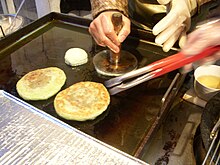| Revision as of 00:26, 27 April 2008 editBadagnani (talk | contribs)136,593 edits wk← Previous edit | Revision as of 00:28, 27 April 2008 edit undoCaspian blue (talk | contribs)Autopatrolled, Pending changes reviewers, Rollbackers35,434 edits rvv by Badagnani Your hidden comments are moved to the talk page. Your original research is not improving the articles! Stop demaging the article.Next edit → | ||
| Line 7: | Line 7: | ||
| |mr=ho ttŏk | |mr=ho ttŏk | ||
| |}} | |}} | ||
| '''''Ho-tteok''''' is a popular ] food of ] and is similar to ]. It is made of wheat flour ]<!--Is it dough or batter?--> with fillings and baked on the sizzling plate. |
'''''Ho-tteok''''' is a popular ] food of ] and is similar to ]. It is made of wheat flour ]<!--Is it dough or batter?--> with fillings and baked on the sizzling plate. It is believed that ''ho-tteok'' originated from Chinese merchants who immigrated to Korea after the late 19th century. Unlike Chinese ]s containing savory meat fillings, ''ho-tteok'' is stuffed with sweet fillings such as brown sugar, honey, chopped ], and ] to suit Koreans' tastes. ''Ho-tteok'' is usually eaten during the winter season. | ||
| ==Varieties== | ==Varieties== | ||
| The types of ''hotteok'' have been changing continuously. In recent years,<!--Please provide approximate date range--> however, new variations have developed - one of them is the well-being ''hotteok''. |
The types of ''hotteok'' have been changing continuously. In recent years,<!--Please provide approximate date range--> however, new variations have developed - one of them is the well-being ''hotteok''. Its dough contains ] so it becomes greenish after baking. Another variety is pink ''hotteok''. Its dough contains added berries, such as '']'' (a ]-like berry that is also used to make Korean berry wine).{{Fact|date=April 2008}}{{Or|date=April 2008}} | ||
| ==Nutrition== | ==Nutrition== | ||
| Line 27: | Line 27: | ||
| ] | ] | ||
| ] | ] | ||
| ] | |||
| {{Korea-cuisine-stub}} | {{Korea-cuisine-stub}} | ||
Revision as of 00:28, 27 April 2008
| Hotteok | |
 | |
| Korean name | |
|---|---|
| Hangul | 호떡 |
| Revised Romanization | ho ddeok |
| McCune–Reischauer | ho ttŏk |
Ho-tteok is a popular street food of South Korea and is similar to pancakes. It is made of wheat flour dough with fillings and baked on the sizzling plate. It is believed that ho-tteok originated from Chinese merchants who immigrated to Korea after the late 19th century. Unlike Chinese rice cakes containing savory meat fillings, ho-tteok is stuffed with sweet fillings such as brown sugar, honey, chopped peanuts, and cinnamon to suit Koreans' tastes. Ho-tteok is usually eaten during the winter season.
Varieties
The types of hotteok have been changing continuously. In recent years, however, new variations have developed - one of them is the well-being hotteok. Its dough contains green tea powder so it becomes greenish after baking. Another variety is pink hotteok. Its dough contains added berries, such as Rubus coreanus (a raspberry-like berry that is also used to make Korean berry wine).
Nutrition
Hotteok is usually eaten during the winter season but it is not recommended to overindulge due its high sugar content; a single hotteok may have as many as 230 calories.
See also
References
- 겨울철에 약이되는음식& 독이되는음식 kukinews 2007.01.07
External links
- Simple info and photo of ho-tteok
- Article about the origin of Ho-tteok and Hobbang "'겨울철 양대 간식' 호빵과 호떡의 넋두리" (in Korean)
This Korean cuisine–related article is a stub. You can help Misplaced Pages by expanding it. |